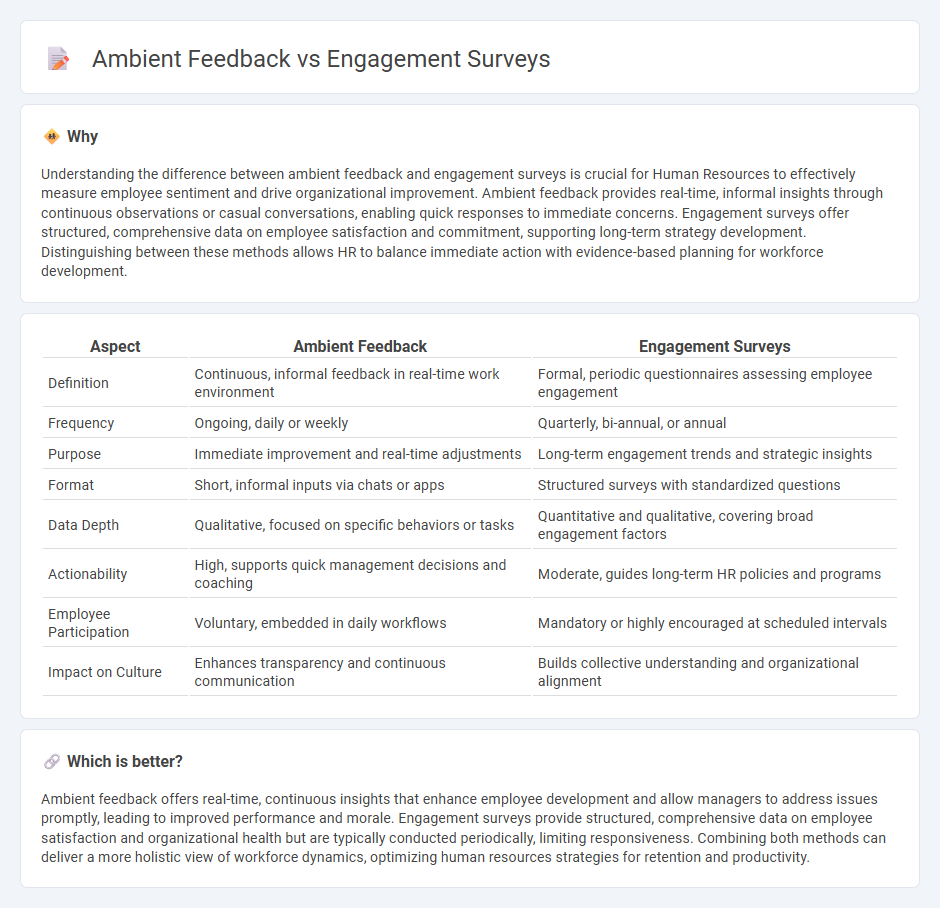
Ambient feedback captures real-time, informal employee insights through continuous communication channels, enabling organizations to address concerns promptly and foster a responsive workplace culture. Engagement surveys provide structured, periodic assessments that measure overall employee satisfaction, commitment, and motivation, delivering comprehensive data for strategic HR decisions. Discover how integrating both methods can enhance your human resources management and improve organizational performance.
Why it is important
Understanding the difference between ambient feedback and engagement surveys is crucial for Human Resources to effectively measure employee sentiment and drive organizational improvement. Ambient feedback provides real-time, informal insights through continuous observations or casual conversations, enabling quick responses to immediate concerns. Engagement surveys offer structured, comprehensive data on employee satisfaction and commitment, supporting long-term strategy development. Distinguishing between these methods allows HR to balance immediate action with evidence-based planning for workforce development.
Comparison Table
| Aspect | Ambient Feedback | Engagement Surveys |
|---|---|---|
| Definition | Continuous, informal feedback in real-time work environment | Formal, periodic questionnaires assessing employee engagement |
| Frequency | Ongoing, daily or weekly | Quarterly, bi-annual, or annual |
| Purpose | Immediate improvement and real-time adjustments | Long-term engagement trends and strategic insights |
| Format | Short, informal inputs via chats or apps | Structured surveys with standardized questions |
| Data Depth | Qualitative, focused on specific behaviors or tasks | Quantitative and qualitative, covering broad engagement factors |
| Actionability | High, supports quick management decisions and coaching | Moderate, guides long-term HR policies and programs |
| Employee Participation | Voluntary, embedded in daily workflows | Mandatory or highly encouraged at scheduled intervals |
| Impact on Culture | Enhances transparency and continuous communication | Builds collective understanding and organizational alignment |
Which is better?
Ambient feedback offers real-time, continuous insights that enhance employee development and allow managers to address issues promptly, leading to improved performance and morale. Engagement surveys provide structured, comprehensive data on employee satisfaction and organizational health but are typically conducted periodically, limiting responsiveness. Combining both methods can deliver a more holistic view of workforce dynamics, optimizing human resources strategies for retention and productivity.
Connection
Ambient feedback continuously captures employee sentiments through unobtrusive means, providing real-time insights into workplace dynamics. Engagement surveys aggregate these sentiments at specific intervals to measure overall employee satisfaction and commitment levels systematically. Integrating ambient feedback data enhances the accuracy and depth of engagement surveys, enabling human resources to implement targeted strategies for improving organizational culture and productivity.
Key Terms
**Engagement Surveys:**
Engagement surveys provide comprehensive insights by collecting structured, quantitative data on employee satisfaction, motivation, and organizational commitment at regular intervals, often quarterly or annually. These surveys analyze key engagement drivers such as work environment, leadership effectiveness, and career development opportunities, enabling targeted action plans. Discover how strategic engagement surveys can transform workplace culture and boost productivity.
Employee Satisfaction
Engagement surveys provide structured, in-depth insights into employee satisfaction by gathering comprehensive data at specific intervals, allowing organizations to identify trends and measure the impact of initiatives over time. Ambient feedback captures real-time, continuous input from employees through informal channels, enabling swift responses to emerging issues and fostering an ongoing dialogue. Discover how combining these approaches can enhance your understanding of employee satisfaction and drive meaningful workplace improvements.
Structured Questionnaires
Engagement surveys rely on structured questionnaires with predetermined questions to systematically measure employee satisfaction, motivation, and workplace engagement levels. Ambient feedback collects real-time, unstructured input from employees through informal channels, offering continuous insights but lacking the consistency of structured data. Explore the benefits and limitations of structured questionnaires in engagement surveys to enhance your employee feedback strategy.
Source and External Links
22 employee engagement survey questions you should... - Offers a set of 22 key questions using a 5-point Likert scale, focusing on pride, advocacy, and recommendations, and encourages open-text responses for deeper employee feedback.
45 Proven Employee Engagement Survey Questions - Provides 45 thoroughly tested questions and explains the use of annual, pulse, and lifecycle surveys to capture comprehensive, timely, and event-specific engagement insights.
Employee Engagement Surveys: Ultimate Guide - Presents 24 example questions tailored to leadership, career opportunities, culture, teamwork, job satisfaction, and work-life balance to help organizations identify actionable areas for improvement.
 dowidth.com
dowidth.com